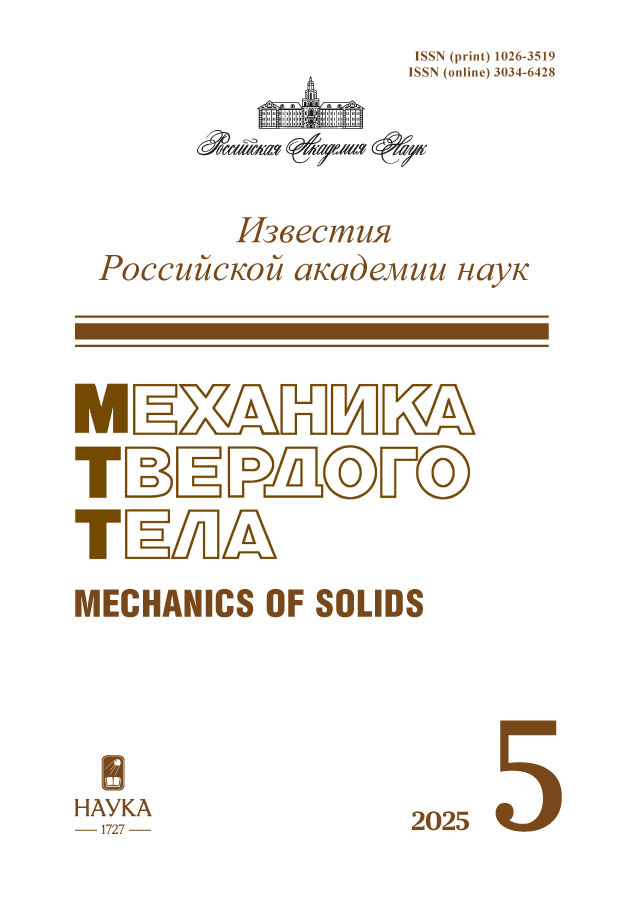Метод определения вязкоупругих свойств поверхностных слоев эластомеров на основе нанодинамического индентирования
- Авторы: Маховская Ю.Ю.1, Морозов А.В.1, Кравчук К.С.2
-
Учреждения:
- Институт проблем механики им. А.Ю. Ишлинского РАН
- НИЦ “Курчатовский институт” — ТИСНУМ
- Выпуск: № 1 (2025)
- Страницы: 116-135
- Раздел: Статьи
- URL: https://rjmseer.com/1026-3519/article/view/680990
- DOI: https://doi.org/10.31857/S1026351925010065
- EDN: https://elibrary.ru/taganx
- ID: 680990
Цитировать
Полный текст
Аннотация
Предложен теоретико-экспериментальный метод для определения механических свойств поверхностных слоев высокоэластичных материалов по результатам их динамического индентирования на малые глубины (наноДМА). В основу метода положено приближенное решение контактной задачи o нагружении осциллирующей нормальной нагрузкой жесткого шарика, контактирующего с деформируемым образцом, который моделируется линейным вязкоупругим полупространством с ядром релаксации в виде суммы экспоненциальных членов. Метод позволяет определять наборы параметров, задающих функции релаксации и ползучести материала во временном интервале, соответствующем диапазону экспериментальных частот, а также динамические модули накопления и потерь для каждой частоты. Продемонстрировано использование метода на примере исследования изменения механических свойств поверхностных слоев для двух типов морозостойких резин (на основе бутадиен-нитрильного и изопренового каучуков) в зависимости от степени износа их поверхностей. Установлено, что изнашивание поверхностей исследованных резин приводит к увеличению жесткости поверхностных слоев и снижению их релаксационных свойств; эти изменения более выражены для резины на основе бутадиен-нитрильного каучука, чем для резины на основе изопренового каучука.
Полный текст
Об авторах
Ю. Ю. Маховская
Институт проблем механики им. А.Ю. Ишлинского РАН
Автор, ответственный за переписку.
Email: makhovskaya@mail.ru
Россия, Москва
А. В. Морозов
Институт проблем механики им. А.Ю. Ишлинского РАН
Email: morozovalexei@mail.ru
Россия, Москва
К. С. Кравчук
НИЦ “Курчатовский институт” — ТИСНУМ
Email: kskrav@gmail.com
Россия, Троицк
Список литературы
- Ферри Дж. Вязкоупругие свойства полимеров. Пер. с англ. М.: Изд-во иностр. лит., 1963. 536 с.
- Горячева И.Г. Маховская Ю.Ю., Морозов А.В., Степанов Ф.И. Трение эластомеров. Моделирование и эксперимент. М.-Ижевск: Институт компьютерных исследований, 2017. 204 с.
- Oliver W.C., Pharr G.M. An improved technique for determining hardness and elastic modulus using load and displacement sensing indentation experiments // J. Mater. Res. 1992. V. 7. № 6. P. 1564–1583. https://doi.org/10.1557/JMR.1992.1564
- Asif S.A.S., Wahl K.J., Colton R.J. Nanoindentation and contact stiffness measurement using force modulation with a capacitive load-displacement transducer // Rev. Sci. Instrum. 1999. V. 70. № 5. P. 2408–2413. https://doi.org/10.1063/1.1149769
- Herbert E.G., Oliver W.C., Pharr G.M. Nanoindentation and the dynamic characterization of viscoelastic solids // J. Phys. D Appl. Phys. 2008. V. 41. № 7. P. 074021. https://doi.org/10.1088/0022-3727/41/7/074021
- Pharr G.M., Oliver W.C., Brotzen F.R. On the generality of the relationship among contact stiffness, contact area, and elastic modulus during indentation // J. Mater. Res. 1992. V. 7. № 3. P. 613–617. https://doi.org/10.1557/JMR.1992.0613
- Igarashi T. et al. Nanorheological mapping of rubbers by atomic force microscopy // Macromolecules. 2013. V. 46. № 5. P. 1916–1922. https://doi.org/10.1021/ma302616a
- Pittenger B. et al. Nanoscale DMA with the atomic force microscope: a new method for measuring viscoelastic properties of nanostructured polymer materials // JOM. 2019. V. 71. № 10. P. 3390–3398. https://doi.org/10.1007/s11837-019-03698-z
- Huang G., Wang B., Lu H. Measurements of viscoelastic functions of polymers in the frequency-domain using nanoindentation // Mech. Time-Depend Mater. 2004. V. 8. № 4. P. 345–364. https://doi.org/10.1007/s11043-004-0440-7
- Cheng Y.-T., Ni W., Cheng C.-M. Nonlinear analysis of oscillatory indentation in elastic and viscoelastic solids // Phys. Rev. Lett. 2006. V. 97. № 7. P. 075506. https://doi.org/10.1103/PhysRevLett.97.075506
- Nikfarjam M. et al. Imaging of viscoelastic soft matter with small indentation using higher eigenmodes in single-eigenmode amplitude-modulation atomic force microscopy // Beilstein J. Nanotechnology. 2018. V. 9. P. 1116–1122. https://doi.org/10.3762/bjnano.9.103
- Greenwood J.A. Contact between an axisymmetric indenter and a viscoelastic half-space // Int. J. Mech. Sci. 2010. V. 52. № 6. P. 829–835. https://doi.org/10.1016/j.ijmecsci.2010.01.010
- Wayne Chen W. et al. Semi-analytical viscoelastic contact modeling of polymer-based materials // J. Tribol. 2011. V. 133. № 4. 041404. https://doi.org/10.1115/1.4004928
- Работнов Ю.Н. Ползучесть элементов конструкций. М.: Наука, 1966. 752 с.
- Джонсон К. Механика контактного взаимодействия. М.: Мир, 1989. 510 с.
- Кристенсен Р. Введение в теорию вязкоупругости. Пер. с англ. М.И. Рейтмана / Под ред. Г.С. Шапиро. М.: Мир, 1974. 338 с.
- Снеддон И. Преобразование Фурье. М.: Иностр. лит, 1955. 668 с.
- Haiat G., Phan Huy M.C., Barthel E. The adhesive contact of viscoelastic spheres // J. Mech. Phys. Solids. 2003. V. 51. № 1. P. 69–99. https://doi.org/10.1016/S0022-5096(02)00059-5
- Argatov I.I., Popov V.L. Rebound indentation problem for a viscoelastic half‐space and axisymmetric indenter — Solution by the method of dimensionality reduction // ZAMM – Journal of Applied Mathematics and Mechanics / Zeitschrift für Angewandte Mathematik und Mechanik. 2016. V. 96. № 8. P. 956–967. https://doi.org/10.1002/zamm.201500144
- Morozov A.V., Bukovskiy P.O. Method of constructing a 3D friction map for a rubber tire tread sliding over a rough surface // J. Frict. Wear. 2018. V. 39. № 2. P. 129–136. https://doi.org/10.3103/S1068366618020113
- Morozov A.V., Makhovskaya Y.Y., Kravchuk K.S. Influence of adhesive properties and surface texture of laminated plywood on rubber friction // J. Frict. Wear. 2021. V. 42. № 4. P. 281–289. https://doi.org/10.3103/S1068366621040085
- Baumgaertel M., Winter H.H. Determination of discrete relaxation and retardation time spectra from dynamic mechanical data // Rheol Acta. 1989. V. 28. № 6. P. 511–519. https://doi.org/10.1007/BF01332922
- Grosch K.A. The relation between the friction and visco-elastic properties of rubber // Proc. R. Soc. Lond. A Math. Phys. Sci. 1963. V. 274. № 1356. P. 21–39. https://doi.org/10.1098/rspa.1963.0112
Дополнительные файлы
















